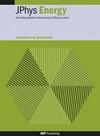Tuning the temperature range of superelastic Ni-Ti alloys for elastocaloric cooling via thermal processing
IF 6.3
3区 材料科学
Q1 ENERGY & FUELS
引用次数: 1
Abstract
Caloric cooling enlisting solid-state refrigerants is potentially a promising eco-friendly alternative to conventional cooling based on vapor compression. The most common refrigerant materials for elastocaloric cooling to date are Ni-Ti based superelastic shape memory alloys. Here, we have explored tuning the operation temperature range of Ni50.8Ti49.2 for elastocaloric cooling. In particular, we have studied the effect of thermal treatments (a.k.a. aging) on the transformation temperature, superelasticity, and elastocaloric effects of Ni50.8Ti49.2 shape memory alloy tubes. The isothermal compressive test revealed that the residual strain of thermally-treated Ni-Ti tubes at room temperature approaches zero as aging time is increased. Short-time aging treatment at 400 °C resulted in good superelasticity and elastocaloric cooling performance with a large tunable austenite finish (A f) temperature range of 24.7 °C, as determined from the A f temperature of the samples that were aged 5–120 min. The main reason of the property change is the formation of a different amount of Ni4Ti3 precipitates in the NiTi matrix. Our findings show that it is possible to tailor the A f temperature range for development of cascade elastocaloric cooling systems by thermally treating a starting single composition Ni-Ti alloy.通过热加工调节超弹性Ni-Ti合金的热弹性冷却温度范围
采用固态制冷剂的热量冷却可能是基于蒸汽压缩的传统冷却的一种很有前途的环保替代方案。迄今为止,用于弹性热冷却的最常见的制冷剂材料是镍钛基超弹性形状记忆合金。在这里,我们探索了调整Ni50.8Ti49.2的操作温度范围,以实现弹性热冷却。特别是,我们研究了热处理(也称为时效)对Ni50.8Ti49.2形状记忆合金管的转变温度、超弹性和弹热效应的影响。等温压缩试验表明,随着时效时间的增加,热处理镍钛管在室温下的残余应变接近零。在400°C下的短时间时效处理产生了良好的超弹性和弹热冷却性能,根据时效5–120分钟的样品的AF温度确定,具有24.7°C的可调奥氏体表面处理(AF)温度范围。性能变化的主要原因是在NiTi基体中形成了不同量的Ni4Ti3沉淀物。我们的研究结果表明,通过热处理起始的单组分镍钛合金,可以为级联弹热冷却系统的开发定制AF温度范围。
本文章由计算机程序翻译,如有差异,请以英文原文为准。
求助全文
约1分钟内获得全文
求助全文
来源期刊

Journal of Physics-Energy
Multiple-
CiteScore
10.90
自引率
1.40%
发文量
58
期刊介绍:
The Journal of Physics-Energy is an interdisciplinary and fully open-access publication dedicated to setting the agenda for the identification and dissemination of the most exciting and significant advancements in all realms of energy-related research. Committed to the principles of open science, JPhys Energy is designed to maximize the exchange of knowledge between both established and emerging communities, thereby fostering a collaborative and inclusive environment for the advancement of energy research.
 求助内容:
求助内容: 应助结果提醒方式:
应助结果提醒方式:


